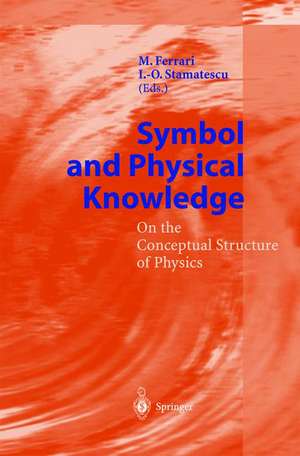Symbol and Physical Knowledge: On the Conceptual Structure of Physics
Editat de M. Ferrari, I.-O. Stamatescuen Limba Engleză Hardback – 28 aug 2001
| Toate formatele și edițiile | Preț | Express |
|---|---|---|
| Paperback (1) | 385.47 lei 43-57 zile | |
| Springer Berlin, Heidelberg – 30 noi 2010 | 385.47 lei 43-57 zile | |
| Hardback (1) | 392.75 lei 43-57 zile | |
| Springer Berlin, Heidelberg – 28 aug 2001 | 392.75 lei 43-57 zile |
Preț: 392.75 lei
Nou
Puncte Express: 589
Preț estimativ în valută:
75.18€ • 81.69$ • 63.19£
75.18€ • 81.69$ • 63.19£
Carte tipărită la comandă
Livrare economică 21 aprilie-05 mai
Preluare comenzi: 021 569.72.76
Specificații
ISBN-13: 9783540414674
ISBN-10: 3540414673
Pagini: 248
Ilustrații: XV, 230 p. 1 illus.
Dimensiuni: 155 x 235 x 19 mm
Greutate: 0.53 kg
Ediția:2002
Editura: Springer Berlin, Heidelberg
Colecția Springer
Locul publicării:Berlin, Heidelberg, Germany
ISBN-10: 3540414673
Pagini: 248
Ilustrații: XV, 230 p. 1 illus.
Dimensiuni: 155 x 235 x 19 mm
Greutate: 0.53 kg
Ediția:2002
Editura: Springer Berlin, Heidelberg
Colecția Springer
Locul publicării:Berlin, Heidelberg, Germany
Public țintă
ResearchCuprins
1. Sources for the History of the Concept of Symbol from Leibniz to Cassirer.- 2. On the Use and Character of Symbols in Modern Physical Theories.- 3. The Symbol in the Theory of Science: Duhem’s Alleged Instrumentalism or Conventionalism and the Continuity of Scientific Development.- 4. Beyond Realism. Symbolism in the Philosophy of Science by Charles S. Peirce and Ernst Cassirer.- 5. Heinrich Hertz and the Concept of a Symbol.- 6. Shifting Symbolic Structures and Changing Theories: On the Non-Translatability and Empirical Comparability of Incommensurable Theories.- 7. Symbol and Intuition in Modern Physics.- 8. Idealizations in Physics.- 9. Symbolizing States and Events in Quantum Mechanics.- 10. The Semiotics of “Postmodern” Physics.
Recenzii
"The book has the important merit of calling our attention to the fundamental problem of sorting out what in physical theories comes from ourselves (the a priori, symbolic, conventional part) and what comes from nature, a question that we are far from having definitely solved." (International Studies in the Philosophy of Science, 17/1, 2003)
Textul de pe ultima copertă
This book tackles the question of the symbolic structure of physics, a topic which is implicit in any theory of knowledge, but one that often seems to be ignored as an explicit and central element in today's epistemological debates. The elucidation of this problem should benefit a number of ongoing discussions and can help to avoid much recurring confusion. The contributions to the book have been chosen so as to provide a coherent view, ultimately addressing the relation between the concepts used in science and the real world. The first part provides an introduction to the problem as it arises in physics, and to the modern history of symbols. The subject of the second part is the epistemological discussion taking place between physicists and philosophers about the role of symbols in our knowledge of Nature. The third part addresses key issues related to the methodology of physics and the character of its symbolic structures. The aim of this book is to provide a consistent, if not comprehensive, view, emphasizing aspects that are paradigmatic for the natural sciences as a whole.
Caracteristici
There is no competitive text The subject is of great philosophical interest Includes supplementary material: sn.pub/extras
















